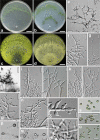Clonal species Trichoderma parareesei sp. nov. likely resembles the ancestor of the cellulase producer Hypocrea jecorina/T. reesei
- PMID: 20817800
- PMCID: PMC2976259
- DOI: 10.1128/AEM.01184-10
Clonal species Trichoderma parareesei sp. nov. likely resembles the ancestor of the cellulase producer Hypocrea jecorina/T. reesei
Abstract
We have previously reported that the prominent industrial enzyme producer Trichoderma reesei (teleomorph Hypocrea jecorina; Hypocreales, Ascomycota, Dikarya) has a genetically isolated, sympatric sister species devoid of sexual reproduction and which is constituted by the majority of anamorphic strains previously attributed to H. jecorina/T. reesei. In this paper we present the formal taxonomic description of this new species, T. parareesei, complemented by multivariate phenotype profiling and molecular evolutionary examination. A phylogenetic analysis of relatively conserved loci, such as coding fragments of the RNA polymerase B subunit II (rpb2) and GH18 chitinase (chi18-5), showed that T. parareesei is genetically invariable and likely resembles the ancestor which gave raise to H. jecorina. This and the fact that at least one mating type gene of T. parareesei has previously been found to be essentially altered compared to the sequence of H. jecorina/T. reesei indicate that divergence probably occurred due to the impaired functionality of the mating system in the hypothetical ancestor of both species. In contrast, we show that the sexually reproducing and correspondingly more polymorphic H. jecorina/T. reesei is essentially evolutionarily derived. Phenotype microarray analyses performed at seven temperature regimens support our previous speculations that T. parareesei possesses a relatively high opportunistic potential, which probably ensured the survival of this species in ancient and sustainable environment such as tropical forests.
Figures



References
-
- Druzhinina, I. S., A. G. Kopchinskiy, M. Komon, J. Bissett, G. Szakacs, and C. P. Kubicek. 2005. An oligonucleotide barcode for species identification in Trichoderma and Hypocrea. Fungal Genet. Biol. 42:813-828. - PubMed
-
- Druzhinina, I. S., M. Komoń-Zelazowska, L. Kredics, L. Hatvani, Z. Antal, T. Belayneh, and C. P. Kubicek. 2008. Alternative reproductive strategies of Hypocrea orientalis and genetically close but clonal Trichoderma longibrachiatum, both capable to cause invasive mycoses of humans. Microbiology 154:3447-3459. - PubMed
-
- Friedl, M. A., M. Schmoll, C. P. Kubicek, and I. S. Druzhinina. 2008. Photostimulation of Hypocrea atroviridis growth occurs due to a cross-talk of carbon metabolism, blue light receptors and response to oxidative stress. Microbiology 154:1229-1241. - PubMed
Publication types
MeSH terms
Substances
Grants and funding
LinkOut - more resources
Full Text Sources

